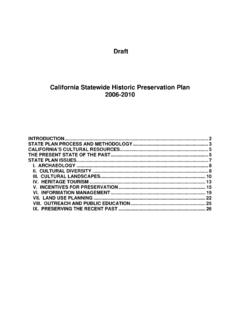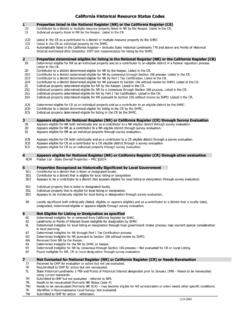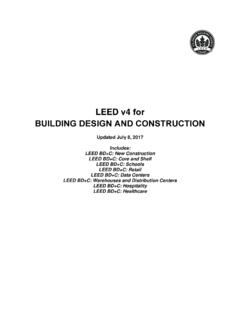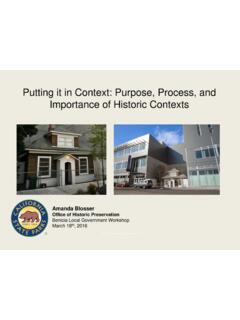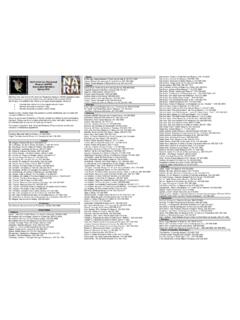Transcription of Attachment C - CA State Parks
1 ASCE Landmark Nomination MQRR Bridge Page 11 Attachment C Historic Photos ASCE Landmark Nomination MQRR Bridge Page 12 Current View of Bridge Mountain Quarries Company railroad and Limestone Quarry - Photograph Log - Page 12CA_El_Dorado_Placer_counties_Mountain_ Quarries_Company_016A hard-hat diver was used in the construction of the Mountain Quarries railroad Bridge. After reaching bedrock, the diver went down and cleaned the rock. Concrete was then poured to create a solid base for the pier. The bridge piers were not solid but built of hollow concrete boxes formed 18 thick and then filled with 1/8 to 3 uncrushed rock. The forms were poured with concrete in 3-4 foot layers. (Courtesy of the california State railroad Museum.)
2 CA_El_Dorado_Placer_counties_Mountain_Qu ar-ries_Company_017A clam shell bucket was used to clean out the 18 thick con-crete form. After the con-crete base was completed, the bucket was used to fill the form with gravel and rock from the river. You can see workers are installing the twisted steel bars used to strengthen the concrete. (Courtesy of the california railroad Museum.)Mountain Quarries Company railroad and Limestone Quarry - Photograph Log - Page 13CA_El_Dorado_Placer_counties_Mountain_ Quarries_Company_019 The construction of the Mountain Quarries railroad Bridge began on the Plac-er County side working across the river to El Dorado County. Temporary build-ings were constructed along the riverbank to house workers and supplies.
3 At the height of construction, a reported 300 men were working on the bridge. The ramp and the tall tower in the photograph were for the delivery of concrete to the site. (Courtesy of Johnson Photography.)CA_El_Dorado_Placer_countie s_Mountain_Quarries_Company_018 Work on the Mountain Quarries railroad Bridge began in 1910. It was constructed by Duncanson & Harrelson Company. The bridge was designed by bridge engineer John Buck Leonard. Leon-ard designed not only this bridge but also many others including the Fern Bridge on the Eel River, which was the largest concrete bridge in the US in 1911. Leonard left a legacy of having designed and engineered more than 40 concrete bridges. (Courtesy of Arthur Sommers.)Mountain Quarries Company railroad and Limestone Quarry - Photograph Log - Page 16CA_El_Dorado_Placer_counties_Mountain_ Quarries_Company_025 This is the nearly completed Mountain Quarries railroad Bridge in early 1912.
4 The bridge was part of the seven-mile standard-gauge railroad that started at the Mountain Quarries in El Do-rado County and ended at Flint Station near Auburn. The rail line was built to haul limestone from the quarry. The temporary construction buildings in this photograph were removed shortly after the bridge was completed. (Courtesy of Johnson Photography.)CA_El_Dorado_Placer_countie s_Mountain_Quarries_Company_024 The bridge under construction in 1911 shows the extensive 8 by 8 wood posts needed to support the forms. The large tower in the middle of the bridge was for delivery of the mixed concrete. The 140 foot arches were hollow and later filled with crushed limestone. The railroad bed on the bridge was filled with sand and topped with limestone then ties and track were laid down.
5 (Courtesy of Donna Howell.) Mountain Quarries Company railroad and Limestone Quarry - Photograph Log - Page 14CA_El_Dorado_Placer_counties_Mountain_ Quarries_Company_021 Downstream of Lyons Bridge, the Mountain Quarries Bridge can be seen under construction in 1911. The Lyons Bridge area was a very busy location during the construction of the railroad . This photograph gives a good view of the large outdoor dance floor. Louis Foscalina s North Fork Saloon sits across the road from the dance floor. (Courtesy of the Placer County Archives.)CA_El_Dorado_Placer_counties_M ountain_Quarries_Company_020 The Mountain Quarries Bridge under construction on the North Fork American River between Placer and El Dorado counties in 1911. (Photograph courtesy of Don McDermott and Karri Sam-son.)
6 Mountain Quarries Company railroad and Limestone Quarry - Photograph Log - Page 15CA_El_Dorado_Placer_counties_Mountain_ Quarries_Company_023 This is the back of the postcard image of the Mountain Quarries railroad Bridge above. It gives a contemporary account of how the third arch was being poured .. when some of the under-pinning let go and the whole of the arch came down with 20 men on it 3 were killed, 5 injured, the others escaping with scratches (some uninjured). (Courtesy of Johnson Photography.)CA_El_Dorado_Placer_countie s_Mountain_Quarries_Company_022 On November 4, 1911, as concrete was being poured, part of the frame work collapsed on the El Dorado side of the Mountain Quarries railroad Bridge. Three men were killed and five were in-jured.
7 Those killed were John Kern, Gust Johnson, and Casaco Angelo. A coroner s inquest found no one at fault in their deaths. The image on this postcard was taken some days before the col-lapse. (Courtesy of Johnson Photography.)Mountain Quarries Company railroad and Limestone Quarry - Photograph Log - Page 17CA_El_Dorado_Placer_counties_Mountain_ Quarries_Company_027 The Mountain Quarries Bridge is completed and is ready for use. Lyon s Bridge can be seen in the background. Lyon s Bridge is now the location of today s Highway 49 Bridge. (Courtesy of Michael Lynch.)CA_El_Dorado_Placer_counties_Moun tain_Quarries_Company_026 The newly completed Mountain Quarries Bridge in 1912 has men working from scaffolding that is hanging on the side of the bridge. (Courtesy of Arthur Sommers.)
8 Mountain Quarries Company railroad and Limestone Quarry - Photograph Log - Page 18CA_El_Dorado_Placer_counties_Mountain_ Quarries_Company_028 The completed Mountain Quarries Bridge and railroad is ready for use. Lyon s Bridge (now Highway 49) can be seen in the background. (Courtesy of Donna Howell.)CA_El_Dorado_Placer_counties_Mou ntain_Quarries_Company_029 Completed on March 23, 1912, the Mountain Quarries railroad Bridge was considered a marvel of engi-neering. It was reported to be the longest span concrete arched bridge for railroad traffic owned by private capitol in the world at the time of its completion as reported by Railway Engineering and Maintenance of Way Magazine, December 1913. The $300,000 cost of the bridge would equal nearly $7 million today.
9 (Courtesy of Michael Lynch.)


